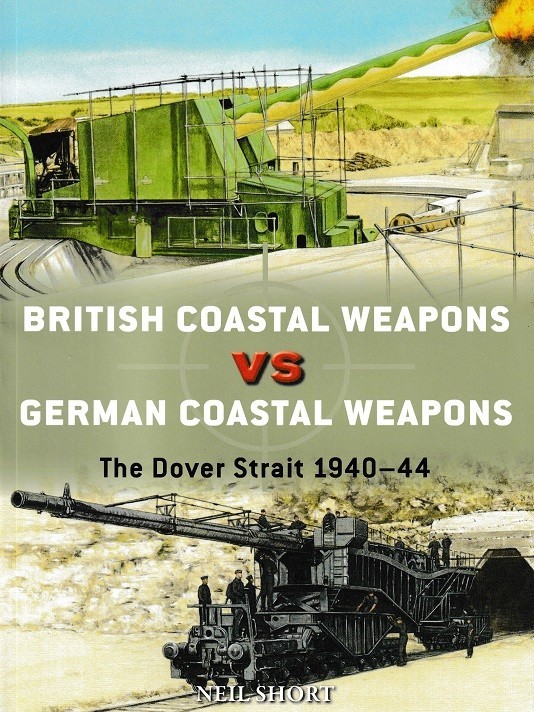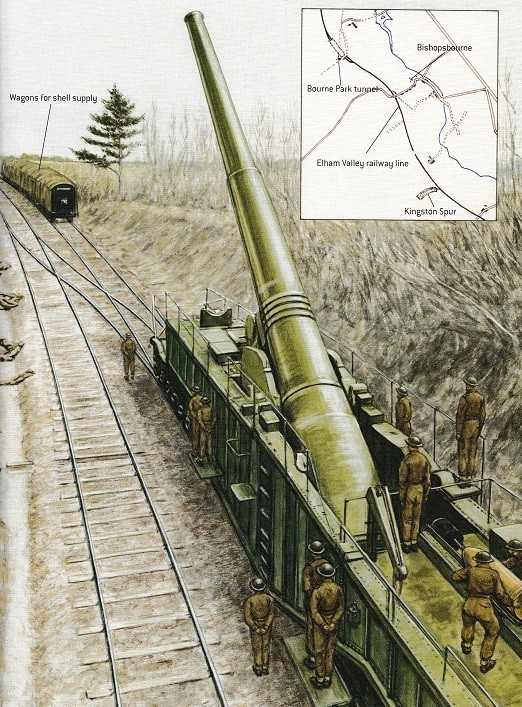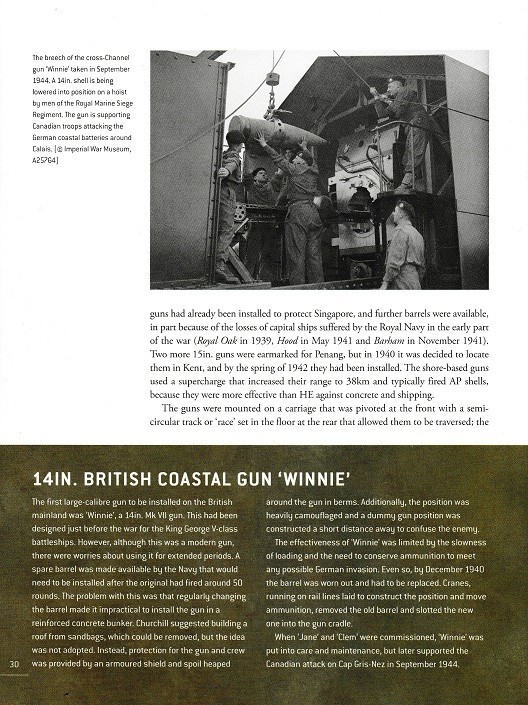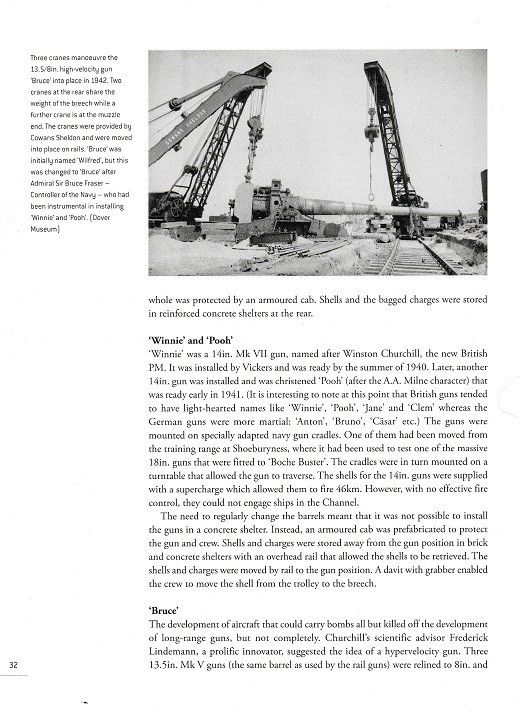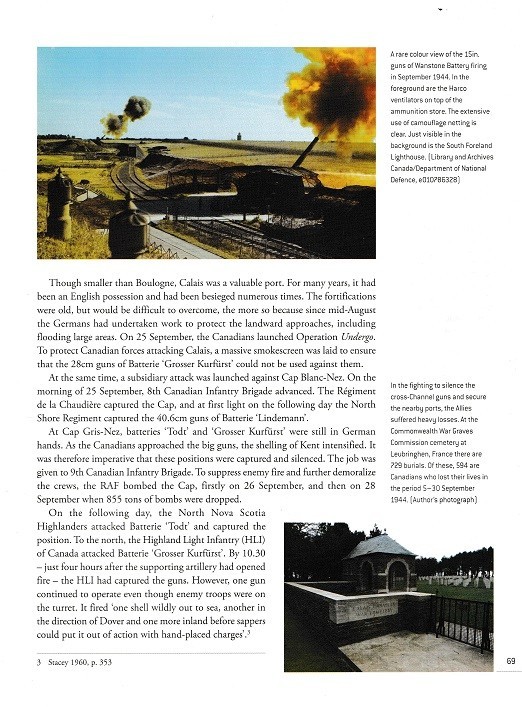HISTORY:
** One of the longest-running battles of World War II took place across the English Channel, in which huge artillery guns attempted to destroy each other, created psychological terror among the local inhabitants living near the coast, and harassed shipping over a four-year period.
In this study, Neil Short examines the array of powerful weapons located across the Dover Strait. Superb colour artworks explore both fixed gun batteries (including 'Jane' and 'Clem', and batteries ‘Todt’ and ‘Lindemann’) and railway artillery (such as the German K5 and K12 guns, and the British 18in. 'Boche Buster'). Construction and targeting technology used by each side are also covered in detail, and the locations of all the major sites around Dover and Calais are pinpointed on easy to follow maps. **
** Quoted from the back cover of the book.
THE BOOK:
Osprey Publications has released British Coastal Weapons vs German Coastal Weapons – The Dover Strait 1940-44 as Number 125 in their Duel series. It is an 80-page soft cover book, 7 x 10 inches in size. Included with the text are black and white and color photographs, color illustrations, color maps, detailed captions and more. It has a 2023 copyright, a publication date of April 25, 2023, and the ISBN is 978-1-4728-4977-9.
THE CONTENTS:
- Introduction
- Chronology
- Design and Development
- The Strategic Situation
- Technical Specifications
- The Combatants
- Combat
- Analysis
- Aftermath
- Glossary
- Bibliography
- Index
THE TEXT:
Author Neil Short provides a well written and informative text detailing British and German emplaced and railway based large caliber coastal weapons used in combat during World War in the Dover Strait area. The contents portion where I listed the contents of the book is accurate as to what is discussed. However, the contents list does not prepare you for the wealth of information provided. The text details specific weapons, both British and German, by the names given to them and details things such as the caliber of the weapon, where they were deployed, the type of weapon such as a rail or static, their rate of fire, if they were radar controlled, their intended targets, their range of traverse, their rate of fire, loading processes, the construction of the batteries, specific dates of combat for specified weapons and their targets and number of rounds fired and the results of the shelling. There is also a section that details combat between British and German coastal weapons and British and German ships. As well as detailing the specific actions the text also discusses the success and failures and overall end and lasting results. Something that I found to be particularly helpful with the information provided by Neil Short is that it is written in a no-nonsense type of writing that provides extremely detailed history and specific information on coastal weapons and he does not use what I would refer to as fluff writing where a large amount of non-essential extra text is provided just to help fill the pages. As I read through the text, I didn’t notice any spelling errors. Grammar and spelling might not be an important factor to everyone however it is something that I take notice of and pass on my findings. Anyone wanting to add an excellent reference and history book on British and German coastal weapons and the combat between them during World War II to their personal library will be pleased with this informative and interesting book.
THE PHOTOGRAPHS:
A total of 25 black and white and 17 color vintage and current photographs are included in this volume. The photographs range from wide angle photographs to close-up detailed photographs. They contain a combination of in-action photographs, photographs removed from motion pictures to photographs that have been staged for the photographer. The majority of the photographs are clear and easily viewable; however, a few have an out of focus look to them and some appear to be too dark, and others appear too light. This is typical for the discussed period of history and the quality of some of the photographs is no fault of the author and do not take anything away from the book. Author Neil Short stuck to the title of the book and chose subject specific photographs and did not include photographs that strayed from the main subject of the book. The majority, if not all, of the photographs will prove to be a wealth of information to anyone interested in British and German coastal weapons and the combat between them during World War II due to the details they contain.
THE ILLUSTRATIONS:
There are 10 color illustrations included in the volume by illustrator Adam Hook. The illustrations are very well done, nicely detailed and are of:
Front Cover
A dual illustration featured on the front cover of the book showing:
- ‘Jane’, one of the 15in. guns at Wanstone Battery. (top illustration)
- German K12 railway gun located at Stützpunkt 192 ‘Bismark’. (bottom illustration)
Plate A
British Rail Gun ‘Boche Buster’
- A one-page illustration showing the British rail gun ‘Boche Buster’ with its crew and ammunition supply wagons. Accompanying the illustration is a well detailed caption and a map insert.
Plate B
Wanstone Battery: 15in. Gun ‘Jane’
- A one-page illustration showing an aerial view of the British battery showing the location of the gun, ammunition magazines, power plant, railway lines and other such items. Accompanying the illustration is a well detailed caption.
Plate C
14in. British Coastal Gun ‘Winnie’
- A one-page illustration showing the British coastal gun ‘Winnie’ with its crew in the process of loading the weapon. Accompanying the illustration is a well detailed caption.
Plate D
German K12 railway gun, Stützpunkt 192 ‘Bismark’
- A one-page illustration showing a German K12 railway gun with its crew outside of its tunnel. Also provided is a well detailed caption and a diagram showing the layout of the tunnels built for the weapon. Accompanying the illustration is a well detailed caption.
Plate E
Marine-Küsten-Batterie ‘Grosser Kurfürst’
- A single cut-away illustration showing the internal arrangement of a German 28cm SK L/50 gun turret emplacement. The illustration shows items of interest such as the cartridge room, shell room, fuel ventilator room, machine room and other such areas. Accompanying the illustration is a well detailed caption.
Plate F
Stützpunkt 89 ‘Fulda’ Rail Gun Bunker
- A one-page illustration showing an aerial view of the German rail gun bunker showing the location of the gun, munitions bunker, cookhouse, loading platform, railway lines, blast wall and other such items. Accompanying the illustration is a well detailed caption and a key pointing out 15 specific points of interest.
Plate G
South Foreland Battery Firing
- A one-page illustration showing an aerial view of the British battery showing the location of the guns, ammunition magazines, observation post, deep shelter and other such items. Accompanying the illustration is a well detailed caption.
Plate H
HMS Erebus Firing on French Coast
- A single illustration showing the port side view of the HMS Erebus, a monitor commissioned in 1916, in action against German gun batteries. Accompanying the illustration is a well detailed caption.
Plate I
The Canadian Attack on Batterie ‘Todt’
- A two-page action illustration showing an aerial view of Canadian Churchill tanks in action against the German Todt casemates. The illustration shows the location of the German casemates, bunkers, trenches and anti-tank ditches. Accompanying the illustration is a well detailed caption.
THE CAPTIONS:
The captions are well written and explain the accompanying photographs and illustrations in great detail eliminating any doubt as to what is shown. The captions go into very specific detail as to the specific type of weapon shown and their caliber, the names given to the guns, details gun emplacements shown, specific targets the guns are firing at, German to English translations, the names of specific individuals and military rank, dates, locations, and other such pertinent information. As I read through the captions, I didn’t notice any spelling or grammatical errors. I was impressed by Neil Short’s captions as they are very helpful to the reader due to their detailed content as opposed to other captions that I have seen that are very brief and lacking in detail.
MAPS:
There are 2 maps included in this volume:
- Locations of British rail-guns, fixed cross-Channel batteries and others
- Locations of German rail-guns, fixed cross-Channel batteries and others
INFORMATIONAL CHARTS:
There are 16 informational charts included in this volume and they provide information on the following:
- Table 1: German static battery locations
- Coastal artillery: German vs British. (number of weapons belonging to each country)
- Table 2: British rail guns
- Table 3: British coastal guns
- Table 4: German rail guns
- Table 5: German coastal guns
- Table 6: Major batteries in and around Dover
- OT (Organisation Todt) hierarchy from Oberbauleitungen down to Baustellen
- Festungspionierstab (Fortress Engineer Staff) 27
- The Seekommandant Pas-de-Calais chain of command in December 1941
- Table 7: German cross-Channel gun manpower complements
- The organization of Artillerie-Kommandeur 141
- Shells hitting St. Margaret’s at Cliffe
- German rail artillery shells fired
- Table 8: Dover damage
- South Foreland fire success
NOTES:
There are 3 notes included in this volume and they are:
- Artist’s note
- Acknowledgements
- A note on measure (Metric to Imperial conversions)
Osprey Publishing also offers British Coastal Weapons vs German Coastal Weapons – The Dover Strait 1940-44 as:
eBook (PDF) ISBN: 978-1-4728- 4976-2
and
Ebook (Epub & Mobi) ISBN: 978-1-4728- 4979-3
Osprey Publishing’s, British Coastal Weapons vs German Coastal Weapons – The Dover Strait 1940-44 is also available as an electronic Kindle version through Amazon.com.
PRICE:
UK £15.99 / US $23.00 / CAN $31.00
This book was provided to me by Osprey Publishing. Please be sure to mention that you saw the book reviewed here on the KitMaker Network when you make your purchase. Thank you.
